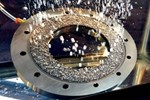Dynamic seals for high-speed centrifugal compressors have been evolving/migrating from oil-based seals to aerodynamic gas bearing type seals over the last 50 years. These seals are known as Dry Gas Seals for a reason, because if any liquid gets drawn across the seal face it boils or burns from the shear heat likely causing seal failure. Drew Devitt, Founder and CTO of New Way Air Bearings has demonstrated aerostatic bearing technology that improves compressor reliability and avoids having to vent or flare fugitive emissions.
Externally Pressurized Porous (EPP) Gas Bearings
By leveraging the pressures that can be generated in the gaps of Exter-nally Pressurized Porous (EPP) gas bearings, a new class of seal offers capablities not preivously available. EPP gas bearings have been used in other industries for decades as bearings but are just now being ap-plied in seal applications for rotating equipment. This effort should: (1) increase the pressures that can be sealed against, (2) reduce the flow of buffer, barrier and seal gases, (3) eliminate friction, heat and ware in seal applications and (4) eliminate fugitive emissions from seals.
First, a quick review of enabling gas bearing technology.
There are two type of gas bearings:
Aerodynamic and Aerostatic. Most large pump and turbine rotors are supported on hydrodynamic oil bearings. Dry Gas Seals (DGS) in compressors are examples of aero-dynmaic gas bearings and many mi-cro turbines are supported on foil type aerodynamic bearings. In all these cases it is the relative motion between the surfaces that draws the fluid or gas into the bearing gaps, so motion is required to generate separation force. This means there will be contact wear at start up, shut down and in slow-speed conditions.
In aerostatic type bearings, motion is not required to generate separation force between the faces, instead a source of externally pressurized flu-id or gas is injected directly between the bearing or seal faces. This pressurized flow is introduced though the faces via precision orifices, grooves, steps or porous compensation techniques, see Figure 1. It is this idea of compensation that is key but not yet well appreciated in the rotating equipment industries.
Compensation is the first restriction, holding back source pressure in re-serve. This enables the faces to run very close together without touching: the closer they get together the higher the gas pressure between them gets. This is because the gap is the second restriction and as it is reduced (increasing the gap restriction) the compensation restriction is relatively less. This allows the pressure gap to increase, creating a separating force. The gas pressure in the gap can be almost as high as the source pressure because the small gap is so restrictive. With flow being a cubed function of the gap, gas consumption is dramatically reduced by the small gaps that become possible.
Diffusion With Porous Media
An elegant method for providing compensation is to diffuse the seal gas though a porous material. This is because the ideal seal design would supply pressure equally across the whole face of the seal and automatically restrict and dampen the flow of air to the face at the same time. The stability of porous media compensation is due to the damping effect from the torturous passageways the gas must flow through to reach the face. This damping effect makes it difficult for the volume of air in the gap to change quickly, resulting in a naturally stable gas film that can-not be plugged by particulates. Even if the supply tubes and/or ports be-come completely full of particulates (sand, dust, teflon tape, etc.), it still does not create as much restric-tion as the porous media itself and none of these contaminants can get though the porous media and into the seal gap. These characteristics make Externally Pressurized Porous (EPP) compensation a good choice for industrial seal applications.
The porous media used is made from familiar materials, such as graphite, carbon or silicon carbide that have proven their plain bearing tribology as contact seal faces, bearings and brushes over decades of use in rotat-ing equipment. So even if the source pressure is lost there is little to no ware and small gaps are maintained.
These materials also have very high heat capability, having been sintered during manufacturing; they resist oxidation to at least 400°C without melting like Babbitt, or burning like polymers. When made from Ceramic Matrix Composites (CMCs) they may operate over 800°C.
EPP gas bearing technology may be applied in many seal applications. Examples of conventional seals that could be replaced with EPP gas seals include packing seals, labyrinth seals, steam seals, bearing isolators, injection-type seals, mechanical seals and DGS.
Read the full article here in the March issue of Fugitive Emissions Journal:


